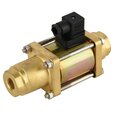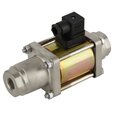Coaxial Solenoid Valve
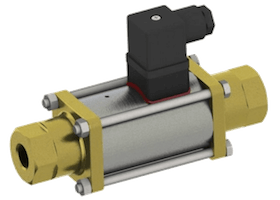
Figure 1: A 2/2-way coaxial solenoid valve
A coaxial solenoid valve is a direct-acting solenoid valve with a relatively unobstructed flow path designed for highly viscous media or high-pressure applications. The unique design of these valves makes them suitable for systems with high flow rate requirements where minimal pressure loss over the valve is desired. They are commonly referred to as just a coax valve.
In general, systems with thick liquids of viscosities over 50 centistokes (square millimeter per second) need special solenoid valves for their control operations. General-purpose solenoid valves cannot be used to regulate thick fluids such as heavy oils, grease, syrups, or other glutinous media. The thick media can block the passageway or cause too high of a required force to open/close the valve rendering it inoperable. Most solenoid valves, when opened, are designed to direct fluid 90 degrees up and over the orifice, then 180 degrees back down under the seal and another 90 degrees towards the outlet. Furthermore, indirect operated solenoid valves make use of small pilot ports with tiny flow paths. While this design works perfectly with low viscosity media (i.e. water, air, or light oils), it will result in a very high-pressure drop over the system if used with thick liquids.
The invention of coaxial solenoid valves has made it possible to control highly viscous fluids by eliminating the obstacles in the path of the fluid. Coaxial solenoid valves are utilized to handle liquids with viscosities of up to 500 or 600 centistokes (CST).
Table of contents
- Coaxial solenoid valve characteristics
- Design and operation
- Types of coaxial solenoid valves
- Features
- Applications
- Selection criteria
View our online selection of coaxial solenoid valves!
Coaxial solenoid valve characteristics
A coax valve offers a variety of advantages over general-purpose solenoid valves. These valves might be the right choice for your application if:
- Your system requires high flow rates and small pressure loss
- Your media is highly viscous (more than 50 CST)
- Your medium is an aggressive, abrasive, slightly contaminated or sensitive gas or liquid
- You have a very high back pressure (up to 400 bars) or pressure fluctuations
- Your system requires quick response times
- Your medium is vacuum up to 10-4 mbar
- Your system experiences zero pressure differential
Design and operation
In a coaxial solenoid valve, the solenoid is installed concentric to an internal laterally movable tube through which the fluid flows (Figure 2). This internal tube is directly connected to a magnetic plunger, which moves parallel to the direction of the flow when the coil is energized. This lateral movement will change the state of the valve to open or closed regardless of system pressure. In a normally closed valve, when the coil is energized, the tube moves against a return spring (not shown in Figure 2) and away from the valve seat (tube moves left in Figure 2), which allows the fluid to flow. By de-energizing the coil, the tube will be pushed back to the valve seat (tube moves right in Figure 2) with the help of the return spring. To prevent media from coming in contact with other internal parts of the valve, the tube is sealed and secured in place with O-rings.
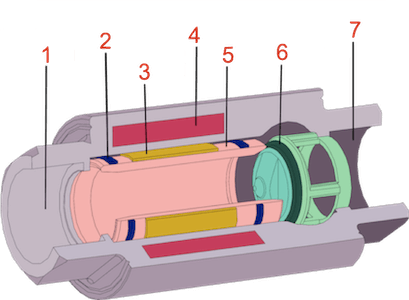
Figure 2: A sectional view of a 2/2-way coaxial solenoid valve when open. Components: valve inlet (1), o-ring seal (2), plunger (3), coil (4), tube (5), valve seat (6), & outlet (7)
Types of coaxial solenoid valves
All coaxial solenoid valves are direct acting in principle which allows them to operate from zero differential pressure. These valves can be 2/2-way or 3/2-way and normally closed or normally open.
In a 2/2-way configuration, depending on whether it is normally closed or normally open, the coaxial solenoid valve can feed the outlet when the coil is energized or de-energized.
A 3/2-way configuration can be used for diverting fluid to a second outlet, as seen in Figure 3. In this configuration, outlet 1 is placed before the tube which is fed by the inlet by default. When the coil is de-energized, the fluid entering from the inlet is exhausted to outlet 1, and the path to outlet 2 is blocked by the valve seat. When the coil is energized, the tube moves away from the valve seat opening outlet 2 while simultaneously sealing the way to outlet 1.
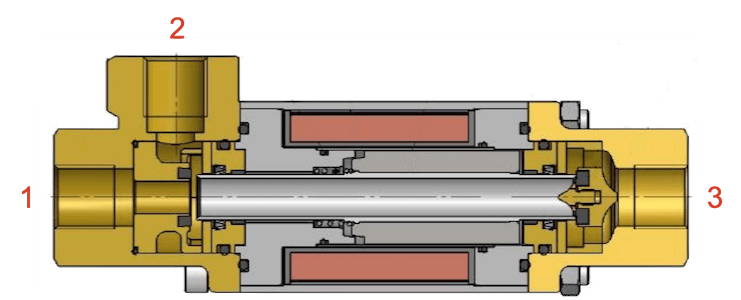
Figure 3: 3/2-way diverting coaxial solenoid valve with one input (1) and two outputs (2 & 3)
Features
-
Free flow path: Since the flow path is relatively free of obstructions, coaxial valves are meant for highly viscous fluids. They can also handle high flow rates with low-pressure loss due to the straightforward design.
-
Unaffected by Pressure: Coaxial solenoid valves can handle pressures of up to 400 bars while also being unaffected by pressure fluctuations at the inlet or outlet. They can also operate at zero pressure differential or in vacuum applications.
-
Response Time: In comparing a coaxial valve to other valves for highly viscous media (motorized ball, gate, butterfly, and globe valves), they are extremely fast-acting. Other solutions can take several seconds to actuate.
-
Position Signaling: Optional position signaling devices can be added during the valve manufacturing process to send open or closed position feedback.
-
Maintenance: Coax valves have a high cycle life, are robust, and require minimal maintenance. However, they can be equipped with manual overrides for ease of commissioning or maintenance purposes.
Applications
The main usage of coaxial solenoid valves are for highly viscous fluids, so systems that contain the following media are great applications for their implementation:
- Most mineral and vegetable oils such as corn oil, olive oil, castor oil, coconut oil, sesame seed oil, palm oil, linseed oil, etc.
- Sour cream
- Butters such as peanut butter, almond butter, hazelnut butter, etc.
- Liquid fats
- Syrup
- Honey
- Ink
- Molten chocolate
- Sauces
- Thick hydrocarbons
The quick response time of these types of valves as well as their availability in 3/2-way functioning configuration make them suitable for precise mixing/dispensing applications.
Selection criteria
The main selection criteria for coaxial solenoid valves are the differential pressure specifications at the ports, KV value, and valve orifice. The material of construction, namely body and seal material, must also be considered for compatibility with media to prevent corrosion and proper valve life.




